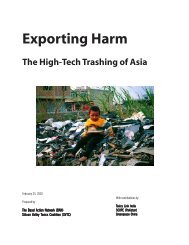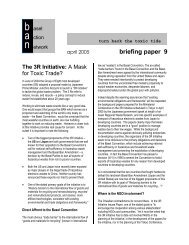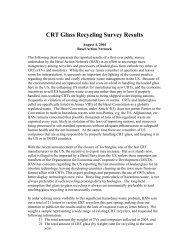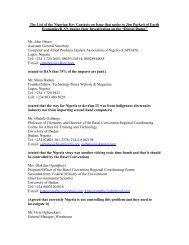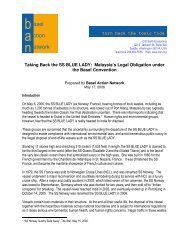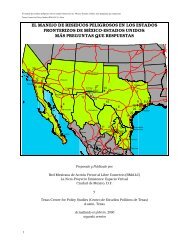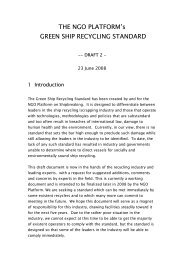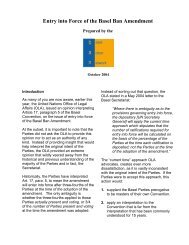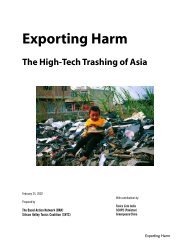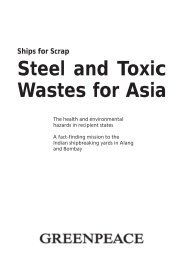The Spot Prawn Fishery The Spot Prawn Fishery - Basel Action ...
The Spot Prawn Fishery The Spot Prawn Fishery - Basel Action ...
The Spot Prawn Fishery The Spot Prawn Fishery - Basel Action ...
Create successful ePaper yourself
Turn your PDF publications into a flip-book with our unique Google optimized e-Paper software.
INTRODUCTION<br />
<strong>The</strong> spot prawn fishery spans diverse habitats<br />
and ecosystems. <strong>The</strong> scientific, management,<br />
and cultural systems that have evolved with it are<br />
equally diverse. <strong>The</strong> <strong>Spot</strong> <strong>Prawn</strong> <strong>Fishery</strong>: A Status<br />
Report seeks to accurately reflect the ecology and<br />
management of this complex fishery. This information<br />
allows identification of aspects of the<br />
fishery that uphold the precautionary principles<br />
of Ecosystem Health and Ecological Economics,<br />
aspects that undermine these tenets and warn<br />
of unsustainability, and aspects that require<br />
further investigation.<br />
Why the <strong>Spot</strong> <strong>Prawn</strong>?<br />
Pressure on marine ecosystems grows each year<br />
as seafood becomes a greater part of the American<br />
diet. Although there is increasing awareness<br />
of the various threats that undermine the viability<br />
of marine ecosystems, existing laws and regulations<br />
have largely failed to secure sustainable fisheries<br />
or to protect the intimate connection between<br />
the economy and the ecosystem evident in marinedependent<br />
communities. <strong>The</strong> record of fisheries<br />
management in the 20th century is dismal.<br />
According to the United Nations’ Food and Agriculture<br />
Organization (FAO), 11 of the world’s 15<br />
most important fishing areas and 60% of commercially<br />
significant fish species are in decline (FAO<br />
1997, McGinn, A.P. 1998). According to an FAO<br />
press release, 25% of the world’s marine fishery<br />
stocks, including many individual species of fish,<br />
are being overfished (Associated Press 2001).<br />
Recently, the United States Department of<br />
Commerce reported that the number of US fish<br />
species in jeopardy continues to rise, and reached<br />
a record 107 species in 2000 (Marine Fish Conservation<br />
Network 2001). Commemorating the United<br />
Nations’ Year of the Ocean (1998), more than 1,600<br />
marine scientists, oceanographers, and fishery<br />
biologists from around the world issued a joint<br />
statement, entitled “Troubled Waters,” alerting<br />
the international community to the global marine<br />
crisis and the forces driving it. <strong>The</strong>se included<br />
pollution, habitat degradation, and wasteful and<br />
destructive fishing practices (MCBI 1998).<br />
<strong>The</strong> problems facing the oceans are clear. As fishery<br />
after fishery collapses, it is imperative that we<br />
ask “Why?” and “What could have been done differently?”<br />
Marine sustainability requires true<br />
understanding of the factors that lead to the<br />
<strong>The</strong> <strong>Spot</strong> <strong>Prawn</strong> <strong>Fishery</strong>: A Status Report<br />
destruction of marine species, and the ecosystems,<br />
economies, and cultures dependent<br />
on them. It requires evolution of existing management<br />
philosophies and paradigms. A broad knowledge<br />
of marine systems and a vision for sustainability<br />
are therefore at the crux of protecting our<br />
natural systems. <strong>The</strong> <strong>Spot</strong> <strong>Prawn</strong> <strong>Fishery</strong>: A Status<br />
Report seeks to assemble this type of information<br />
for one marine species before it is too late.<br />
Shrimp Fisheries in Context<br />
Shrimp—harvested in the wild or produced via aquaculture—are<br />
generally characterized as among<br />
the most unsustainable of all global fisheries.<br />
Destructive fishing methods, vast quantities of<br />
bycatch, loss of mangroves, and coastal pollution<br />
are only a few of the serious environmental and<br />
social problems that have been associated with<br />
the wild harvest and aquaculture of shrimp. Yet<br />
shrimp is also one of the fastest-growing and most<br />
lucrative global and domestic seafood markets.<br />
Shrimp are one of the most valuable seafood<br />
products imported into the United States. In 2000,<br />
US shrimp imports were valued at US $3.8 billion.<br />
In 2001, imports are expected to reach 775–785<br />
million pounds—a value of between US $3.5 and<br />
$3.8 billion (Department of Agriculture 2001).<br />
<strong>The</strong> National Marine Fisheries Service reports<br />
that nearly one billion pounds of shrimp were<br />
consumed in the US in 1998, and that consumption<br />
levels continue to rise (National Marine<br />
Fisheries Service 1999a).<br />
Unfortunately, the vast majority of shrimp consumers<br />
do not know that the unsustainable production<br />
and harvest of shrimp is devastating<br />
ecosystems and local communities. Moreover,<br />
they have no way of identifying or ordering sustainably<br />
produced shrimp in a restaurant or<br />
supermarket. <strong>The</strong>re is a critical need to establish<br />
an ecologically certified, sustainable shrimp fishery<br />
that can be used to educate consumers, shift<br />
seafood demand to more ecologically sound<br />
products, and dramatically reduce demand<br />
for unsustainably produced seafood.<br />
<strong>The</strong> <strong>Spot</strong> <strong>Prawn</strong> <strong>Fishery</strong><br />
<strong>The</strong> spot prawn fishery on the West Coast of<br />
North America, extending from Alaska to<br />
California, has great potential to be an exception<br />
to the ecological and social destruction that typifies<br />
many shrimp fisheries. This potential is a<br />
function of several factors:<br />
•the ecological sensitivity of spot prawns and<br />
1



